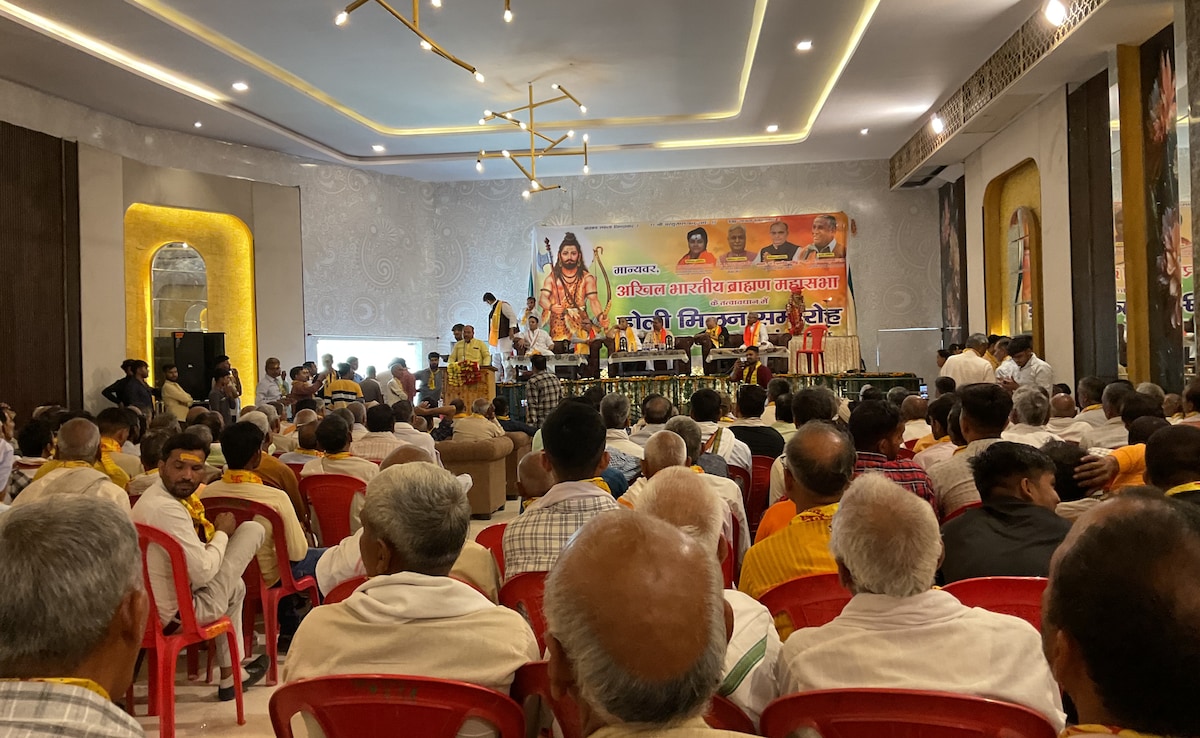A group of Jatavs in Fatehpur village, Aligarh
Photo Credit: Smita Gupta
I visited Fatehpur two years ago in 2022, ahead of the assembly polls in Uttar Pradesh. I returned there earlier this week to find that physically, there had been no material change. In the village of Fatehpur, just 28 km from the university town of Aligarh, a majority of the homes still look half-finished. Hidden among these cheerless homes, stand the ruins of abandoned havelis, their exquisitely carved wooden doors the only reminder of a grander past, when wealthy Bania families dominated the life and economy of this village – and indeed, owned most of the farming land in the vicinity.
In the early 1990s, when the Indian economy was beginning to open up, according to a member of the community, some Banias were attacked in the village. A combination of opportunity and tragedy led to a mass exodus. They shifted base to Aligarh, Delhi and Ballabgarh to make a fresh start. But those who left Fatehpur did not sell their land: instead, they rented it to the Jats from neighbouring villages who farm the land for them.
With the departure of the landed Banias, the Jatavs, a Scheduled Caste community, became the dominant group in Fatehpur, one of a cluster of villages that make up the gram panchayat of Rajpur. Its members account for 40% of the current population here, says Sanjay Diwaker, the former pradhan of Rajpur, and now the state general secretary of the youth wing of the Rashtriya Lok Dal (RLD).
Banias With BJP
The Banias, who are still in the village, say they are firmly with the Bharatiya Janata Party (BJP), but the Brahmins are facing a dilemma: there are two candidates from their community, the BJP’s Satish Kumar Gautam, who is also the sitting MP, and the Bahujan Samaj Party (BSP)’s Hitendra Upadhayay. With Gautam having served two undistinguished terms that have left his constituents unhappy, the Brahmins are a divided lot.
Manoj Kumar Sharma says, “The Brahmins and the Banias will all vote for the BJP, as they did last time. We need the BJP to ensure that the Harijan Act [the Scheduled Castes (Prevention of Atrocities) Act] is not used against us,” His brother, Narender Pal Sharma, nods.
In another part of the village, Chotey Lal Sharma echoes the same sentiments, but then adds that in an hour’s time, the Akhil Bharatiya Brahmin Mahasabha is holding a meeting just on the outskirts of Aligarh city to decide whom the community should vote for. I take his cue and go to the Mahasabha: to my surprise, it is a huge affair, with the convention hall bursting at the seams. Their foreheads smeared with chandan, the Brahmins gathered here vow to vote for the BSP candidate.

The Akhil Bharatiya Brahmin Mahasabha
Photo Credit: Smita Gupta
The Khatiks and the Dhobis in Fatehpur, like in the last elections, indicated that they would vote for the BJP again.
The Jatavs are a critically large community in Aligarh, in which Fatehpur is located: they are the third-largest group and number over 2 lakh; the Muslims, followed by the Jats are, however, the largest communities in Aligarh.
Munshilal, a Jatav, says firmly, “In the past, after we stopped voting for the Congress, we have been voting for Behenji [Mayawati] and we will do so this time, too.”
The Muslims are largely plumping for the SP-Congress candidate, Brijendra Singh, though a few say that if they feel by voting day that the BSP candidate has a better chance against the BJP, they might vote for “Behenji“. Sayeeda, an old woman, says, “We voted for Akhilesh’s Samajwadi Party [SP] party last time and will do so again. But we don’t mind if the BSP wins too – we like Behenji too. She makes us feel safe.”
In 2022, the SP and the Rashtriya Lok Dal (RLD) fought together; now, the RLD is in alliance with the Bharatiya Janata Party (BJP), and the SP with the Congress. This should, in principle, help the BJP, but it appears after conversations in the village that RLD supporters are divided: Gautam, the sitting BJP MP who has been renominated, is struggling this time to garner mass support here, and RLD loyalists say that if there had been a nominee by the party, it would have helped them make up their mind.
Common Concerns
Outside a little shop, I met two Balyan brothers – Jaats – in their late teens and early twenties. Kapil Balyan, who has just completed his Class 12, says he may just vote NOTA (None Of The Above). The strapping youths all had ambitions of joining the army like their father and grandfather, but competition is tough, and four years under the Agniveer scheme seem difficult. So the two now look after the farm – one oversees the animals, and the other minds a small dhaba (roadside eatery) the family runs.
Across the village, cutting across the communities, the biggest complaint was that there were no jobs, and education was expensive. The village only has one school – till Class 8. After that, those who want to continue studying have to go to Khair, the tehsil headquarters; colleges are even further away, in Aligarh. “Earlier, there was NREGA (a reference to jobs under the Mahatma Gandhi National Rural Employment Guarantee Act); now, even that is not there,” says Munshilal.
Hopes, ambitions, old rivalries, and changing party alliances will all play a role in these elections.
(Smita Gupta is a senior Delhi-based journalist)
Disclaimer: These are the personal views of the author
Meet Mahtab Ahmad, known for his keen insights into the latest trends and news. Join Mahtab on his blog, where every post is a exploration of the ever-evolving now.